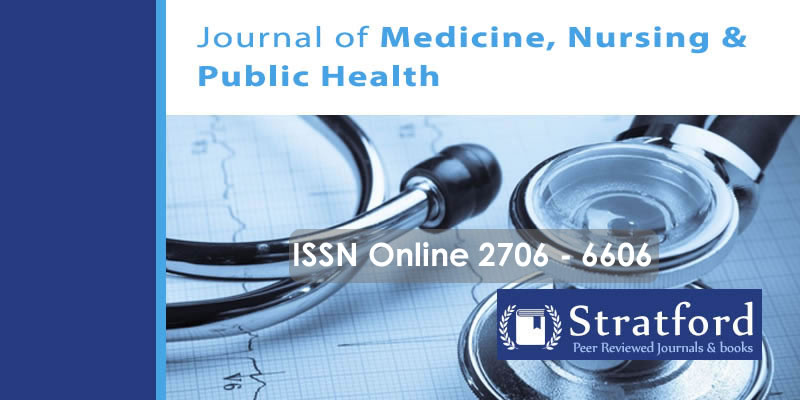Assessing Factors Hindering Effectiveness of Family MUAC Program on Nutrition Surveillance and Early Detection of Malnutrition Cases Among Children Aged 6-59 Months in Banisa Sub County
DOI:
https://doi.org/10.53819/81018102t30153Abstract
The Family MUAC Program, which trains mothers and caregivers to use a Mid-Upper Arm Circumference (MUAC) tape to detect malnutrition in children, has improved nutrition surveillance and early detection of malnourished children. This study assessed the factors hindering the effectiveness of family MUAC programs on nutrition surveillance and detection of malnutrition among children aged 6-59 months in Banisa Sub-County, Mandera County. The study objectives were to assess the influence of mothers' characteristics and socio-economic factors on nutrition surveillance and early detection of malnutrition cases. The study was guided by Cognitive Behavioral Theory (CBT) and adopted a descriptive correlation research design. The target population was 293 mothers from Banisa Sub-County, and the sample size was determined through the census method. Primary data was collected using questionnaires and interview guides and analyzed using SPSS version 26. The response rate was 89% (209 out of 236). The findings showed a positive relationship between socioeconomic factors and the effectiveness of family MUAC programs (r(204) = .232, p = .001). On the contrary, there was no significant influence between mothers’ characteristics factors and MUAC programs (r(204) = .030, p = .489). The study recommendations and conclusion aimed at exploring the feasibility and accuracy of incorporating MUAC measurements into family-based programs for detecting and addressing malnutrition, providing valuable insights into the implementation and efficacy of MUAC-based screening initiatives in community settings.
Keywords: Mid-Upper Arm Circumference (MUAC), Mandera County, nutrition surveillance, nutrition, family-based programs
References
Albanus, F. S., & Ashipala, D. O. (2023). Nutritional knowledge and practices of mothers with malnourished children in a regional hospital in Northeast Namibia. Journal of Public Health in Africa, 14(8).
Andersen, C. T., Chopra, P. K., Dave, N., Hariprasad, D., Kak, M., Pandey, R., ... & Chaudhery, D. N. (2024). Maternal and child nutrition services associated with nutritional knowledge and practices, India. Bulletin of the World Health Organization, 102(1), 9.
Barcus, G. C., Papathakis, P. C., Schaffner, A., & Chimera, B. (2021). Nutrition screening, reported dietary intake, hospital foods, and malnutrition in critical care patients in Malawi. Nutrients, 13(4), 1170.
Bliss, J., Lelijveld, N., Briend, A., Kerac, M., Manary, M., McGrath, M., ... & Mayberry, A. (2018). Use of mid-upper arm circumference by novel community platforms to detect, diagnose, and treat severe acute malnutrition in children: a systematic review. Global Health: Science and Practice, 6(3), 552-564.
Chitekwe, S., Biadgilign, S., Tolla, A., & Myatt, M. (2018). Mid-upper-arm circumference-based case-detection, admission, and discharging of under five children in a large-scale community-based management of acute malnutrition program in Nigeria. Archives of Public Health, 76, 1-10. https://doi.org/10.1186/s13690-018-0266-4
County, L., & Virginia, W. (2022). Economic Development Strategic Plan for 2022-2026.
Global Nutrition Project. (2022). Chapter 02: The burden of malnutrition. https://globalnutritionreport.org/reports/global-nutrition-report-2018/burden-malnutrition/
Guldan, G. S. (2020). Undernutrition and overnutrition: the challenging double burden of malnutrition. Good Health and Well-Being, 747-759.
Kayembe, A. M. (2022). Factors Associated with Under-Five Mortality at Tembisa Hospital, Gauteng Province, South Africa (Doctoral dissertation, University of Johannesburg).
Khan, A. M., Sharmin, R., & Ahasan, M. F. (2022). Accuracy of Mid-Upper Arm Circumference for Detecting Acute Malnutrition in Children Aged 6–59 Months in an Urban Slum in Bangladesh: A Cross-Sectional Analysis. Cureus, 14(12).
Mohamed, H. J. J., Loy, S. L., Mitra, A. K., Kaur, S., Teoh, A. N., Rahman, S. H. A., & Amarra, M. S. (2022). Maternal diet, nutritional status and infant birth weight in Malaysia: a scoping review. BMC pregnancy and childbirth, 22(1), 294. https://doi.org/10.1186/s12884-022-04616-z
Morris, N., Sheru, W., Satoshi, K., Mohammed, K., & Makokha, A. (2017). Nutritional status and association of demograohic characteristics with malnutrition among children less than 24 months in Kwale County, Kenya. The Pan African Medical Journal.
Mulama, L. A. (2023). Nutrition Status of Children Under Five Years (During Corona-19 Pandemic) in Kibera Informal Settlement in Nairobi, Kenya (Doctoral dissertation, University of Nairobi).
Ndemwa, M., Wanyua, S., Kaneko, S., Karama, M., & Anselimo, M. (2017). Nutritional status and association of demographic characteristics with malnutrition among children less than 24 months in Kwale County, Kenya. The Pan African Medical Journal, 28.
NDMA. (2022). Mandera County 2022 Long Rains Food and Nutrition Security Assessment Report.
http://knowledgeweb.ndma.go.ke
Nutrition Health. (2023). Kenya Nutrition Situation Overview, July 2023. https://nutritionhealth.or.ke/wp-content/uploads/2023/11/Nutrition-Situation-Overview-2023-Final.pdf
Perry, H. B., Zulliger, R., & Rogers, M. M. (2014). Community health workers in low-, middle-, and high-income countries: an overview of their history, recent evolution, and current effectiveness. Annual review of public health, 35, 399-421. https://doi.org/10.1146/annurev-publhealth-032013-182354
Shahid, M., Ahmed, F., Ameer, W., Guo, J., Raza, S., Fatima, S., & Qureshi, M. G. (2022). Prevalence of child malnutrition and household socioeconomic deprivation: A case study of marginalized district in Punjab, Pakistan. PloS one, 17(3), e0263470. https://doi.org/10.1371/journal.pone.0263470
UNICEF. (2020). Nutrition: Kenya. https://www.unicef.org/kenya/nutrition
Zhu, P. H., Mhango, S. N., Vinnakota, A., Mansour, M., & Coss-Bu, J. A. (2022). Effects of COVID-19 pandemic on nutritional status, feeding practices, and access to food among infants and children in lower and middle-income countries: a narrative review. Current Tropical Medicine Reports, 9(4), 197-206.


